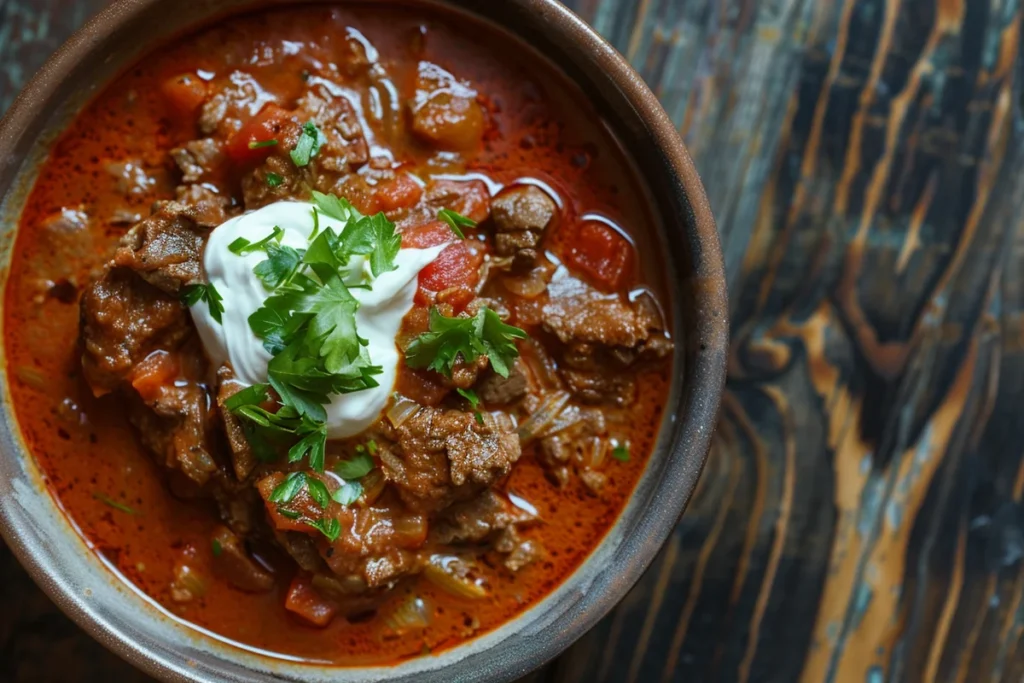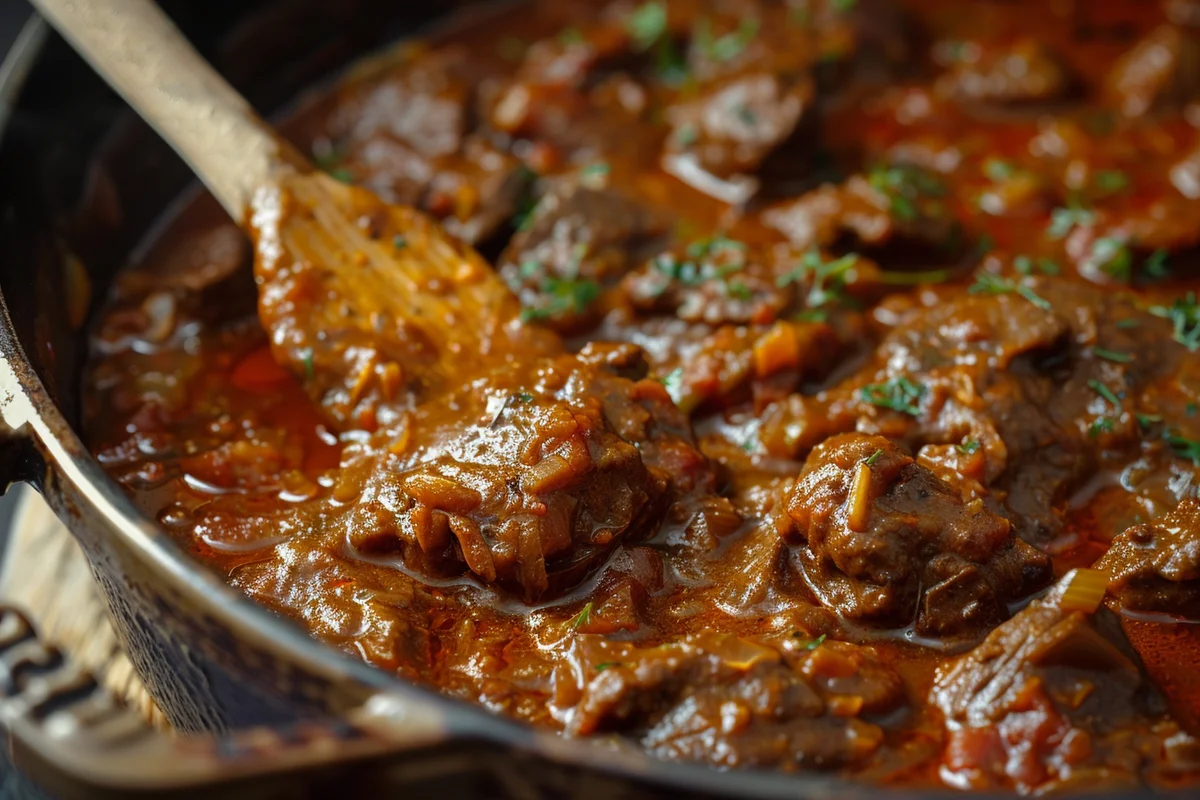If you’ve ever savoured a steaming bowl of goulash, you may have wondered what is goulash sauce made of? Goulash sauce is the heart of the dish, providing its distinctive savoury flavour and rich aroma. It’s a perfect balance of spices, vegetables, and meat, which has made it a beloved staple in Hungarian cuisine. In this comprehensive guide, we’ll dive deep into the ingredients that make goulash sauce so special, how to prepare it, and some variations that highlight its versatility.
The Origins of Goulash and Goulash Sauce
The origins of goulash trace back to Hungary, where it was traditionally prepared by shepherds (or gulyás, from which the dish derives its name) over open fires. This simple but flavorful dish started as a basic stew made with meat, onions, and water. Over time, it evolved into the rich and hearty goulash we know today, with goulash sauce being its signature element.
Originally, the dish’s main purpose was sustenance. However, as paprika became more widely available in Hungary during the 18th century, it was added to the stew, forever changing its flavour profile. Paprika, along with other key ingredients, now defines the soul of the dish. The goulash sauce is the base that gives the meal its iconic colour and taste, and it’s what makes goulash stand out from other types of stews.
Hungarian goulash sauce remains the most popular and authentic version, often slow-cooked to bring out the bold flavours of the ingredients.
For more historical context about Hungarian cuisine and its evolution, you can explore the History of Hungarian Cuisine.
Difference Between Goulash and Goulash Sauce
Before we dive into the specifics of goulash sauce, it’s essential to understand the distinction between the entire goulash dish and the sauce itself. While goulash is the complete meal—often served as a stew made with meat, vegetables, and noodles—goulash sauce is the flavorful base that pulls everything together.
What Is Goulash Sauce?
- It is the rich broth or gravy that provides depth to the dish.
- It typically contains paprika, garlic, and onions, which are slow-cooked to enhance their flavours.
- The sauce is often used as a foundation, allowing the meat and vegetables to soak in its essence.
What Makes Up a Goulash Dish?
Essential Ingredients of Goulash Sauce
Each ingredient in goulash sauce plays a key role in creating its unique balance of flavors. Let’s explore the essentials.
Paprika: The Heart of Goulash Sauce
Paprika is the star ingredient, giving goulash its deep red color and smoky flavor. Hungarian paprika, known for its sweetness and warmth, is most commonly used.
- Sweet paprika offers a mild flavor and warming sweetness.
- Hot paprika adds a fiery kick, ideal for those who enjoy heat. You can combine both to tailor the spice level.
Adding paprika early in the cooking process allows it to bloom, enhancing its flavor.
Onions and Garlic: Building the Base
Onions and garlic are crucial for a rich base. she break down as they cook, thickening the sauce and adding natural sweetness. Garlic intensifies the aroma and depth of the sauce.
Meat: Enhancing Richness
While not technically part of the sauce, meat—often beef—is browned first to add depth. Its fat enriches the sauce during simmering.
Caraway Seeds: The Secret Spice
A dash of caraway seeds brings a slightly anise-like flavor that enhances the complexity of the sauce. Use sparingly to avoid overpowering the dish.
Broth or Water: Liquid Foundation
Beef broth is preferred for a meat-based goulash, adding richness, while vegetable broth works well for vegetarian versions.
Tomatoes (Optional)
Some variations include tomatoes or tomato paste, adding a tangy brightness and sweet acidity to the sauce.
Step-by-Step Guide to Making Goulash Sauce
Here’s how you can prepare an authentic goulash sauce step by step.

Prepare the Base
- Sauté onions and garlic in oil or butter until golden brown. This creates the flavour foundation for your sauce.
- Add paprika and caraway seeds to the sautéed onions and garlic. Stir them for a few minutes to release their aromas. This step is crucial to ensuring the spices bloom properly.
Brown the Meat
- Once the base is ready, add your chosen meat (typically beef). Browning the meat seals in the juices and helps build a richer flavour.
- Be sure to brown the meat on all sides before adding liquid.
Add Broth and Simmer
- Pour in your choice of broth (or water) and bring the mixture to a boil.
- Once boiling, reduce the heat to a simmer and let the sauce cook slowly. The longer it simmers, the more the flavours will meld together.
Adjust the Consistency
- If the sauce is too thin for your liking, you can thicken it by adding a slurry of flour or cornstarch mixed with water. Stir this into the sauce until it reaches your desired consistency.
- Alternatively, if you want a soupier sauce, add more broth.
Season and Taste
- Adjust the seasoning by adding more salt, pepper, or paprika to taste.
- Remember to taste frequently as you cook to ensure the flavours are well-balanced.
Variations of Goulash Sauce
Although Hungarian goulash sauces is the most well-known, several variations around the world are worth exploring.
- American Goulash Sauce
- American goulash is often a tomato-based sauces that includes ground beef and pasta.
- It’s thicker and heartier than its Hungarian counterpart, with a sweeter, tangier flavour thanks to the use of tomatoes.
- German Goulash Sauce
- German goulash sauces tends to be more vegetable-heavy, using bell peppers, carrots, and tomatoes.
- This version is often served with dumplings or potatoes.
- Vegetarian Goulash Sauce
- For a vegetarian twist, replace the meat with hearty vegetables like mushrooms or eggplant.
- A rich vegetable broth can substitute for beef broth, still providing plenty of flavor.
Serving Suggestions for Goulash Sauce
Goulash sauces is versatile and can be served in many ways, depending on your preferences.

- Serve Over Noodles, Rice, or Potatoes
- A classic way to enjoy goulash is by serving the sauces over egg noodles, rice, or mashed potatoes. These starches absorb the rich sauce, making every bite more flavorful.
- Pair with Crusty Bread or Dumplings
- Hungarian dumplings (nokedli) or a slice of crusty bread are perfect for soaking up the goulash sauces.
- Add a Dollop of Sour Cream
- Many people top their goulash with a spoonful of sour cream, which adds a creamy, tangy element to the dish.
Storing and Freezing Goulash Sauce
Goulash sauce can be stored and even frozen for later use.
- Refrigeration: Store leftover goulash sauces in an airtight container in the fridge for 3-4 days.
- Freezing: Goulash sauces freezes well for up to 3 months. Be sure to cool it completely before transferring it to freezer-safe containers.
For a detailed guide on storing sauces, check out this article on How to Freeze and Reheat Sauces.
Frequently Asked Questions About Goulash Sauce
- Can I use chicken instead of beef in goulash sauces?
Yes, you can use chicken in goulash sauces, but it will result in a lighter flavour compared to beef.
- How long does goulash sauces last in the fridge?
Stored properly in an airtight container, goulash sauces can last for up to 4 days in the refrigerator.
- Is goulash sauces gluten-free?
Traditional goulash sauces is naturally gluten-free. However, if thickening agents like flour are used, be sure to check for gluten-free alternatives.
- Can I make goulash sauces in a slow cooker?
Absolutely! Goulash sauces can be slow-cooked for a deeper, richer flavour. Brown the meat and sauté the onions before transferring everything to the slow cooker.
- What type of paprika is best for goulash sauces?
Hungarian sweet paprika is the most authentic choice, but you can mix it with hot paprika to adjust the heat level to your liking.
With this detailed guide, you now know exactly what goulash sauces is made of and how to prepare it like a pro. Whether you’re making an authentic Hungarian version or experimenting with new ingredients, mastering goulash sauces will elevate your cooking game. Happy cooking!

